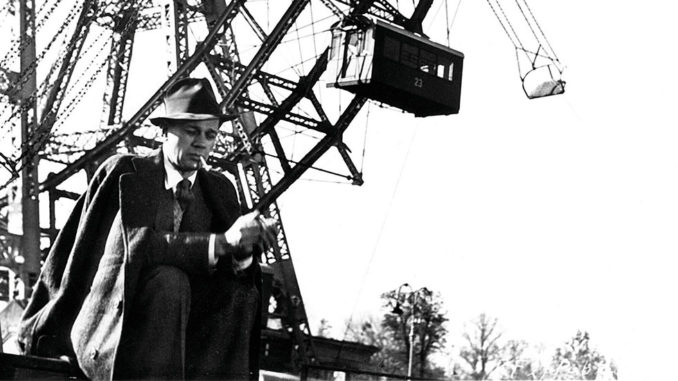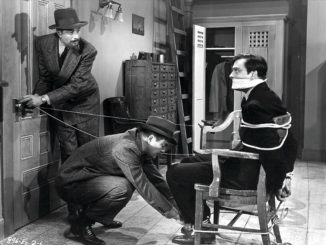
by Robert Lattanzio
I stood at the foot of the Riesenrad (the giant Ferris wheel) in the Prater, a park in Vienna, Austria, and looked up at the gondola cars suspended nearly 200 feet above me. I had seen this wheel once before while watching an old, scratched print of The Third Man, an atmospheric thriller shot largely on location in post-World War II Vienna.
I love watching all kinds of movies, but have a particular fondness for the stylish intrigue of film noir. And The Third Man certainly delivers. “I never knew the old Vienna before the war, with its Strauss music, its glamour and easy charm,” begins the opening voice-over narration. With a documentary-like montage, I was quickly introduced to a city laid partly in ruin, divided and occupied by foreign powers, and riddled with racketeers.
Sitting in that darkened theatre in LA 25 years ago, I had no idea that within a couple months I’d be in Vienna working as a production assistant on a movie, a period drama being co-produced with the Mafilm Hunnia Film Studio in Budapest, Hungary. Since graduating from college a few years earlier, I’d managed to land a few industry jobs, but had yet to make it out of the shipping room and onto a movie set. So when a producer I’d met the year before offered me work on his film, I quit my job, packed my bags, and headed straight for the airport.
In The Third Man, Joseph Cotton plays Holly Martins, an American pulp fiction writer who has come to Vienna at the invitation of Harry Lime, played by Orson Welles. No sooner has Martins arrived when he’s plunged into an intricate mystery involving his old friend Lime.
Watching The Third Man today, I’m still absorbed by its twisting plot, complex characters, atmospheric photography and skillfully edited sequences.
The movie cleverly uses its Viennese locations to deepen the intrigue; the city itself becomes a character in the film. Much of the shooting was done at night, turning the streets into a labyrinth of darkness and light. Shadows sweep across buildings, and increasingly raked camera angles highlight Martins’ disorientation as he tries to figure out what’s happened to his friend.
Everywhere our crew filmed, I looked for signs of The Third Man’s locations. “This building looks familiar,” I thought. “Perhaps it’s the café where the stakeout occurs. Maybe that’s the plaza where Lime disappears.” In hindsight it seems ridiculous. Vienna is a large city, and no doubt much had changed in the decades since the movie was shot.
I was nothing if not enthusiastic, however, working on my first movie in the same city where this classic film was shot. So with a map, a few subway tokens, and an extremely limited German vocabulary, I set out to find one of The Third Man’s most famous locations and step into a bit of film history.
In a pivotal scene, Martins waits for Lime at the base of the Riesenrad, the giant wheel looming above him. They get into one of the cars, standing face-to-face but on different sides of an ethical divide. Although their conversation begins amiably, the tension is evident. The mood becomes threatening when Lime slides open the door of their gondola, which by now is hanging hundreds of feet in the air. With the possibility of one pushing the other out, the suspense reaches a crescendo.
I have a particular fondness for the stylish intrigue of film noir, and The Third Man certainly delivers.
I arrived at the Prater and was elated––the wheel was still standing. Ignoring my fear of heights, I stepped into the car. In the time it took for the doors to slide shut, I realized I’d made a big mistake. The wheel slowly turned, the gondola slowly rose, and the pit in my stomach slowly grew larger as the view of Vienna grew more spectacular. I tried not to think about Orson Welles sliding the door open. An eternity later (or maybe it was five minutes), I stepped back onto solid ground, glad that my brush with film history was over.
Our crew soon finished its location work in Vienna and returned to Hungary to shoot the remaining scenes. After production wrapped, I stayed on as a post PA. The assistant editors taught me some of the mechanics of the cutting room––how to thread a Steenbeck, how to log and code footage, and how to rewind film without destroying it or my hands. Mostly, however, I watched the two editors at work and started to learn about how to cut a movie. I was hooked.
Watching The Third Man today, I’m still absorbed by its twisting plot, complex characters, atmospheric photography and skillfully edited sequences (the chase in Vienna’s sewer system immediately comes to mind). But I’m also reminded of the early days of my career, when working in movies went from being an aspiration to a reality, and I realized that the cutting room was exactly where I wanted to be.
Oh, and never to set foot on the Riesenrad again.





